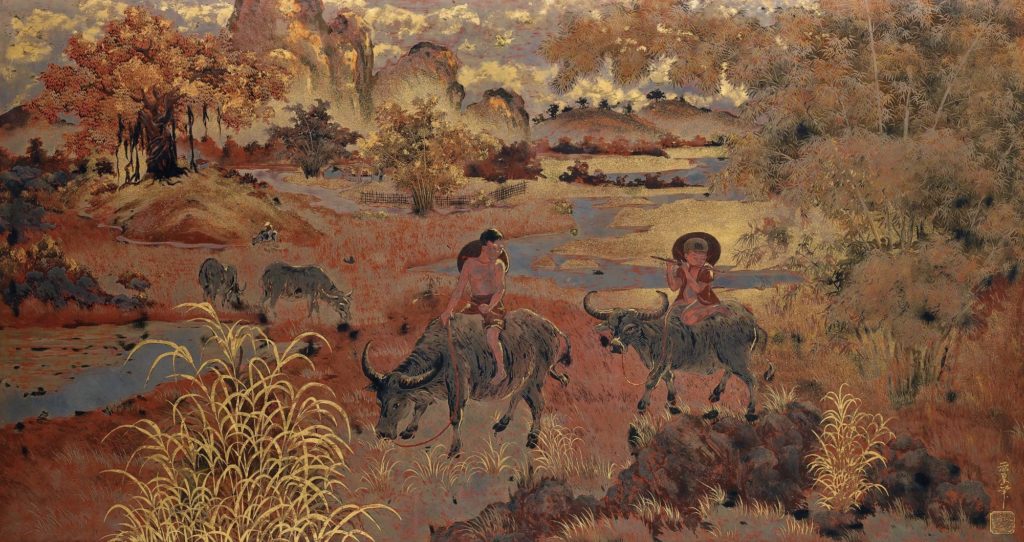Pham Hau – « Young Cowherds in Tonkinese Landscape »
The artwork we proudly present here is a magnificent and seductive lacquer on board. It distinguishes itself not only because of its rich aesthetic qualities, but also because it represents a milestone in the history of Vietnamese art. The work displays a high level of technical ability, as the lacquer process can be long and unyielding, and the historical context surrounding the work marks and illustrates a significant moment in Vietnamese painting.

Pham Hau attended the Indochina School of Fine Arts in Hanoi from 1929 to 1934, in the fourth generation of students since the opening of the school. These times bore major upheavals in the Vietnamese political, social and artistic landscape. While the search for beauty was a key component to the teachings of the Hanoi School of Fine Arts, the troubled political and social context of the time would have had a great influence on its students, and would have encouraged them to question their surroundings.
Lacquer was taught as a subject of its own from the early 1930s. Pham Hau was one of its most talented, competent and gifted students, alongside Nguyen Gia Tri and Tran Quang Tran.
The rhus succedanea tree is the primary source of lacquer in Tonkin. The resin is extracted by incision and can be first transformed into two colours: canh gian (cockroach wings) and den (black). The red, obtained from cinnabar, allows the artist to work with a polychromatic palette. The gold affixed seen here completes a clever and patient work of sandpapering, a process that allows no errors from the artist. This is key to a better understanding of the work accomplished here.

Our lacquer presented here is remarkable on two levels. Firstly, it is created on a single large panel, which is very rare, exemplifying the medium’s expressive potential. Secondly, to our knowledge today, its subject is unique in Pham Hau’s body of work. The artist did not want his work to be a work of mere pageantry, he depicts a simple scene with two cowherds, one of them a musician, set in a peaceful pastoral in a Tonkinese landscape. It could well be somewhere on the road between Hanoi and Hoa-Binh, not far from Dong Ngac, the painter’s native village.
The phantasmagorical vision of this landscape beautifully contrasts with an almost ethnographic depiction of the two young cowherds in their environment. The exceptional depth found in this painting is highlighted by the different levels of the landscape, from the bamboo and the tree at the foreground, to the buildings in the middle ground. The eye of the viewer is then attracted to the faraway magnificent and dreamy landscape, a pictorial symphony indeed.
Doan Phu Tu (1910-1989) could have honoured this work with his magnificent poem Colours of Time :
« Not blue, the colour of time
Mauve is the colour of time
Not intoxicating, the perfume of time
Light is the perfume of time. »
The artist’s chromatic range, where reds and greys are intensified by extensive applications of gold, are typical of the works from the 1930s and 1940s, giving the work a great sense of gravitas and dignity. The richness of the painting is also defined by the contrast in the alternate use of varnished and matte areas in the lacquer. This beautiful panel can be dated around 1938, considering the signature is entirely in Chinese characters and is accompanied by a very sophisticated seal. It is only later that Pham Hau started signing his works with his Roman name (sometimes together with his Chinese name) and would favour creating lacquer screens with arguably more decorative elements over large panels.
These two lovely cowherds, one a musician, exemplify Pham Hau’s sheer talent to overcome the material harshness of the task at hand, lending an enduring effect of art in everyday life.
It is an exceptional work of true quality, a beautiful ode to the artist and his talent.
Jean-Francois Hubert